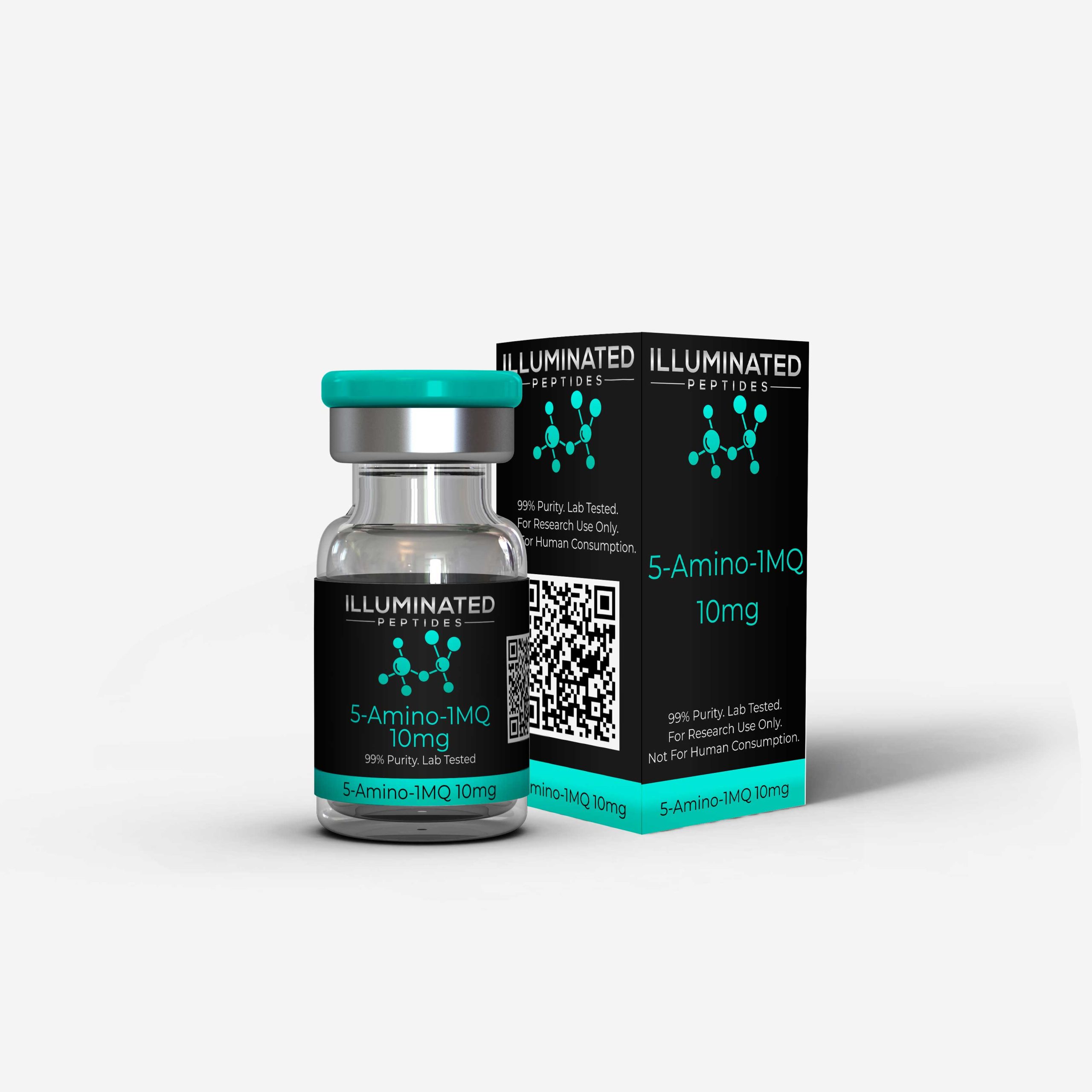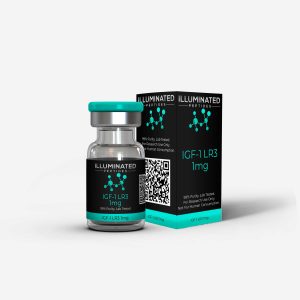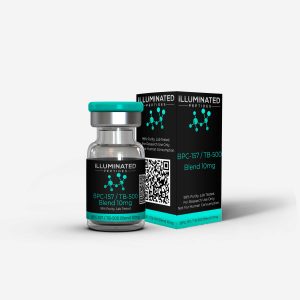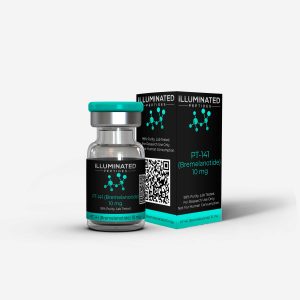Description
5-Amino-1MQ Overview
(5-amino-1-methylquinolinium), a structural analogue of methylquinolinium, is a small-molecule inhibitor of the cytosolic enzyme nicotinamide N-methyltransferase (NNMT). NNMT is closely associated with cellular energy regulation and has been studied for its role in metabolic balance. Blocking NNMT activity has been shown in research settings to influence body composition, leading to reduced adipocyte size, alterations in fat mass, and measurable changes in plasma biomarkers such as glucose and cholesterol.
5-amino-1MQ, along with other methylquinolinium-based compounds, is currently being investigated in laboratory studies for its potential effects on metabolic processes. Experimental findings also suggest that NNMT inhibition may enhance stem cell activity and support regenerative responses in skeletal muscle tissue, making it a compound of interest in ongoing biochemical and metabolic research.
5-Amino-1MQ Structure
Molecular Formula: C10H11N2
Molecular Weight: 159.21 g/mol
PubChem CID: 950107
CAS Number: 42464-96-0
Synonyms: 5-amino-1-methylquinolinium
5-Amino-1MQ Research
Obesity
Nicotinamide N-methyltransferase (NNMT) is a cytosolic enzyme present in a wide range of tissues, with the highest concentrations observed in liver and adipose cells. Research in animal models indicates that elevated NNMT expression is associated with reduced levels of the glucose transporter GLUT4. GLUT4, which is primarily located in striated muscle (skeletal and cardiac) and adipose tissue, plays a major role in regulating glucose uptake and overall energy balance. In rodent studies, animals with greater GLUT4 expression display heightened insulin sensitivity, whereas those with reduced GLUT4 levels demonstrate impaired insulin signaling.
GLUT4 activity has also been connected to basal metabolic rate and the concepts of “fast” and “slow” metabolism. Experimental data suggest that organisms with high GLUT4 expression may expend more energy, while those with low GLUT4 expression conserve more calories. Exercise has been shown to upregulate GLUT4 production, offering insight into how physical activity contributes to energy balance and glucose regulation. NNMT and GLUT4 appear to be closely linked in these processes. According to Dr. Barbara Kahn of Harvard Medical School, this relationship was one of the original reasons NNMT was studied as a possible regulatory factor in obesity and metabolic imbalance. Elevated NNMT expression has been observed in adipose tissue of animals with insulin resistance, and modulation of this enzyme has been shown to influence weight and metabolic function in preclinical models.
Metabolism in mammals is highly efficient, designed to maximize energy yield from available calories. While this efficiency is generally beneficial, in environments of excess caloric intake it may contribute to fat accumulation. For this reason, identifying strategies that reduce metabolic efficiency has long been of interest in experimental research. Findings suggest that NNMT, through its relationship with GLUT4, could be a key player in this process.
At the biochemical level, NNMT regulates the conversion of nicotinic acid (NA) into 1-methylnicotinamide (1-MNA). Altering this pathway through NNMT inhibition has been shown in preclinical settings to increase caloric expenditure while reducing storage. Research with NNMT blockers such as 5-amino-1MQ has demonstrated increased GLUT4 expression, greater glucose utilization, and enhanced metabolic activity. Animal studies have reported outcomes including reduced adiposity, improved insulin sensitivity, and altered lipid profiles, all without changes in food intake. For example, one study showed mice administered 5-amino-1MQ experienced a 7% decrease in body mass and a 30% reduction in fat mass over 10 days.
Additional research suggests that NNMT inhibition may influence lipid signaling. By boosting GLUT4, 5-amino-1MQ appears to encourage adipocytes to produce a distinct class of lipids called PAHSAs (palmitic acid esters of hydroxy-stearic acids). These compounds have been shown in animal studies to improve insulin sensitivity and reduce inflammation, making them a notable subject of current metabolic research. Although this area of study is still emerging, it highlights potential new directions for understanding NNMT’s role in adipose biology.
5-Amino-1MQ and Muscle Function
The effects of NNMT inhibition in muscle tissue mirror those observed in adipose tissue, with increased GLUT4 expression and greater energy turnover. Recent findings in aged animal models indicate that NNMT blockade, including through compounds such as 5-amino-1MQ, may also stimulate muscle stem cell activity.
In one study, 24-month-old mice treated with an NNMT inhibitor showed enhanced muscle stem cell activation following injury, compared to controls. Treated mice displayed myofibers nearly twice as large in cross-sectional area and demonstrated higher contractile strength, with reports of up to 70% greater force compared to untreated groups. These findings suggest that NNMT inhibition may impact muscle regeneration and repair in preclinical settings.
Increased NNMT expression has also been reported in muscle-wasting conditions such as Duchenne Muscular Dystrophy (DMD). Studies suggest that lowering NNMT levels may help counteract some of the mechanisms underlying impaired stem cell function in these disorders. Beyond stem cell activity, another proposed mechanism involves NAD+ replenishment. NNMT inhibition increases NAD+ availability, which is known to support mitochondrial function, reduce fibrosis, and lower inflammation. These effects, observed in animal models, have been linked to improvements in muscle physiology and cardiac performance.
A Possible Role for 5-Amino-1MQ in Cognition
NAD+ is essential for energy homeostasis within the brain and for communication across synaptic junctions. Decreases in NAD+ levels have been associated with reduced neuronal signaling and impaired neuromuscular communication in animal models. Research indicates that restoring NAD+ can enhance synaptic transmission and overall cognitive performance in preclinical settings.
Although 5-amino-1MQ has not yet been extensively studied in this context, its demonstrated ability to increase NAD+ levels in other tissues has prompted interest in exploring whether similar effects may occur in the brain. Ongoing studies are aimed at determining the potential relevance of NNMT inhibition to cognitive performance and neurological research.
NNMT and Cancer
Elevated NNMT expression has been observed in several forms of cancer, including gastric, pancreatic, renal cell carcinoma, and bladder cancers. Experimental evidence from knockout models suggests that reduced NNMT activity is associated with resistance to tumor formation, leading to speculation about a possible role for this enzyme in cancer biology. Current investigations are focused on understanding whether NNMT inhibition might influence cancer progression or aggressiveness. However, results remain preliminary, and the role of 5-amino-1MQ in this area of research has not been fully established.
5-Amino-1MQ Summary
5-amino-1MQ is a cell-permeable analogue of methylquinolinium that has been studied for its ability to inhibit nicotinamide N-methyltransferase. NNMT is strongly associated with metabolic regulation, adiposity, glucose balance, and energy expenditure in animal models. Research indicates that reducing NNMT activity with 5-amino-1MQ alters metabolic processes, promotes changes in adipocyte function, and modulates muscle and nerve physiology. Additional investigations suggest a possible connection between NNMT inhibition and cancer biology.
Altogether, 5-amino-1MQ represents an important tool for ongoing laboratory studies exploring the complex roles of NNMT in metabolism, muscle biology, neurochemistry, and disease research.




